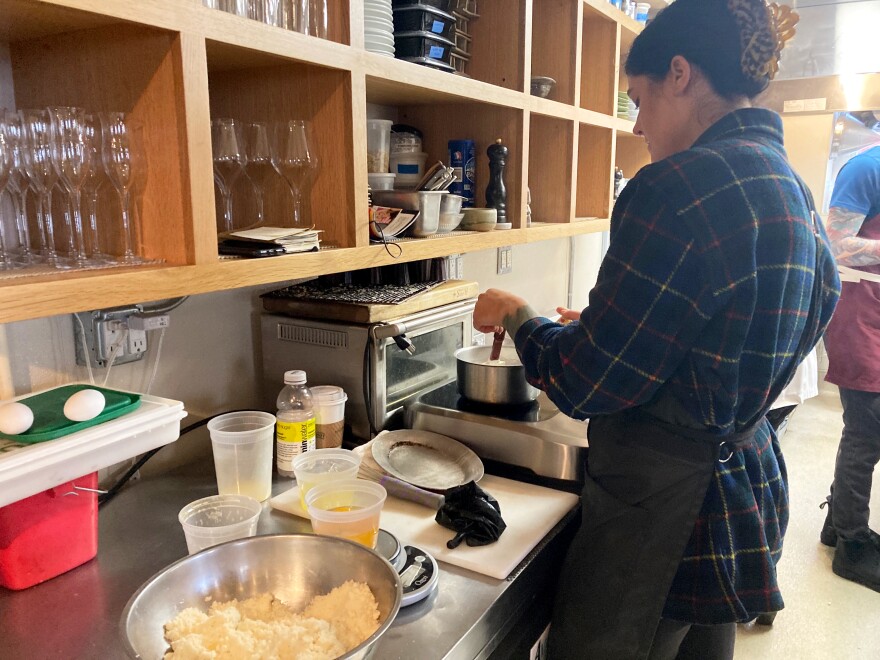Earlier this year, debate over gas stoves rose to a fever pitch, after new evidence that the stoves create pollution that is a risk to public health. It led to the latest culture war: gas versus electric induction.
At Milwaukee’s Ardent, induction has actually been behind the counters ever since the restaurant opened more than a decade ago. That’s a rarity in restaurants, fine-dining or not.
On a Wednesday afternoon, Ardent’s kitchen hums. Literally, with the sound of the cooler. But prep for dinner service is also underway. Nicholas Pissare, the chef de cuisine, sears an army of duck breasts over the sleek induction cooktop. As they sizzle, they take on the color of deep caramel.
Pissare picks a temperature, and since it’s induction, it’ll stay there. “There’s no guessing what medium is, right?” he says. “This is 1200, this is how we do it every time.”
The medium-low heat lets him sear the duck as long as possible, rendering the fat.
I notice the temperature of the room, too. Without open flames, it’s unusually cool for a busy kitchen.
“This is by far the coolest kitchen I’ve ever worked in, just because there is no gas,” Pissare says.

It’s also safer. Induction works by sending electromagnetic energy directly to pots and pans, as opposed to typical electric or gas stoves which heat cookware indirectly. That means burns are rare.
“I’ve never worked at a restaurant where you can touch a handle without a towel before,” Pissare says. “[With] induction, things just don’t get hot as often.”
In addition to these advantages, more and more research shows electric stoves are better for our health and the environment. Gas stoves create pollutants that can cause or trigger respiratory illnesses like asthma. They also leak methane, which contributes to climate change.
Still, some insist gas is the only way to go. Many cooks like the visual cues of cooking with gas. The sight of flames licking the bottom of a pan seems more effective than a slick surface.
“I’m old-school, even though I’m younger,” Pissare says. “Some old-school chefs are like, ‘everything has to be cooked over the flame.’ There’s no way you could tell the difference.”
Chef and owner Justin Carlisle says induction here was a matter of necessity. Ardent is on the lower-level of an apartment building on the east side. To accommodate a gas stove, he would have had to install a vent all the way through five stories and out the roof.
“Financially, it would have cost us three times as much to do an exhaust system for gas as it did to build the entire restaurant,” he says.
A decade later, Carlisle doesn’t have regrets. There’s just one surface to wipe down and clean. And, this isn’t your grandma’s electric stove. Induction is powerful and consistent, great for long braises and high sears.
And rapid boils. Carlisle’s other restaurant, Red Light Ramen, is just next door.
“We’re doing 55 quarts on a stock burner,” he says. “That is going to be a faster boil, a more consistent boil, to emulsify our ramen stocks than it would if we had a normal gas stove.”
Americans tend to romanticize gas stoves. Carlisle says maybe it’s a throwback to humanity’s earliest days. “It goes back to the caveman ways,” he says. “Fire and the nature of how us as a species were brought up.”
But the fixation also rose, in no small part, from the gas industry. In the 1930s, a public relations executive with the American Gas Association coined the slogan “now you’re cooking with gas.”
He fed it to comedy radio shows and the phrase worked its way through the culture. Over the decades, the gas industry has poured money into ads that depict gas stoves as a symbol of class and sophistication.

Carlisle says the domination of gas means fewer options for restaurants and homeowners.
“Electricity and induction and all these items coming about are wonderful,” he says. “I just wish we could find it to be more accessible, to give more options to people. Instead, more options are directly gas-related.”
Back at meal prep, pastry chef Ariel Welch mixes batter for canelés, a molded French pastry. Her recipe calls for warming up the milk, then cooling it down.
“90 degrees Celsius and then I have to bring it down to 70,” she says.
On any other stove, you’d have to watch milk like a hawk, lest it boil over. But, with induction, Welch says she has better control. She walks off to fetch something, cool as a cucumber.
There’s one more unexpected perk to induction, Welch jokes. When she worked in kitchens with gas, her forearms were bare. It’s not that she has dark arm hair, but the flame singed it right off. Cooking on induction, it’s since grown back.





